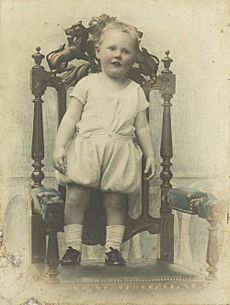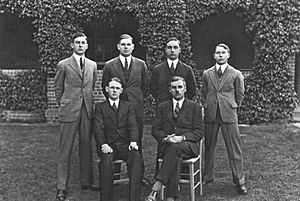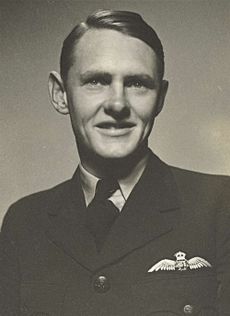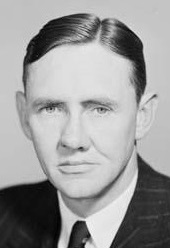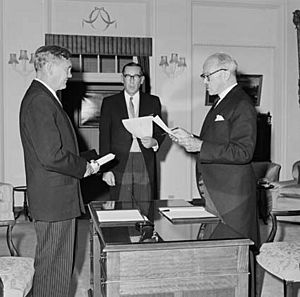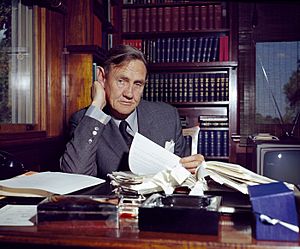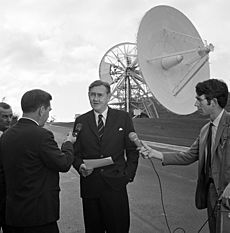John Gorton facts for kids
Quick facts for kids
John Gorton
|
|
|---|---|
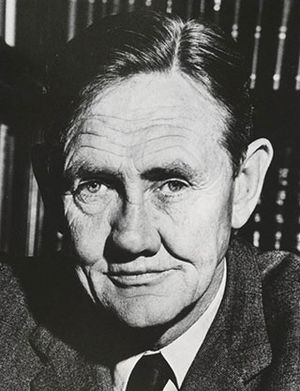
Gorton in January 1968
|
|
| 19th Prime Minister of Australia | |
| In office 10 January 1968 – 10 March 1971 |
|
| Monarch | Elizabeth II |
| Governor-General | Lord Casey Sir Paul Hasluck |
| Deputy | John McEwen Doug Anthony |
| Preceded by | John McEwen |
| Succeeded by | William McMahon |
| Minister for Defence | |
| In office 19 March 1971 – 13 August 1971 |
|
| Prime Minister | William McMahon |
| Preceded by | Malcolm Fraser |
| Succeeded by | David Fairbairn |
| Minister for Education and Science | |
| In office 16 February 1962 – 28 February 1968 |
|
| Prime Minister | Robert Menzies Harold Holt John McEwen Himself |
| Succeeded by | Malcolm Fraser |
| Leader of the Government in the Senate | |
| In office 16 October 1967 – 1 February 1968 |
|
| Preceded by | Denham Henty |
| Succeeded by | Ken Anderson |
| Minister for Works | |
| In office 18 December 1963 – 28 February 1967 |
|
| Prime Minister | Robert Menzies Harold Holt |
| Preceded by | Gordon Freeth |
| Succeeded by | Bert Kelly |
| Minister for the Interior | |
| In office 18 December 1963 – 4 March 1964 |
|
| Prime Minister | Robert Menzies |
| Preceded by | Gordon Freeth |
| Succeeded by | Doug Anthony |
| Minister for the Navy | |
| In office 10 December 1958 – 18 December 1963 |
|
| Prime Minister | Robert Menzies |
| Preceded by | Charles Davidson |
| Succeeded by | Jim Forbes |
| Leader of the Liberal Party | |
| In office 9 January 1968 – 10 March 1971 |
|
| Deputy | William McMahon |
| Preceded by | Harold Holt |
| Succeeded by | William McMahon |
| Deputy Leader of the Liberal Party | |
| In office 10 March 1971 – 18 August 1971 |
|
| Prime Minister | William McMahon |
| Preceded by | William McMahon |
| Succeeded by | Billy Snedden |
| Member of the Australian Parliament for Higgins |
|
| In office 24 February 1968 – 11 November 1975 |
|
| Preceded by | Harold Holt |
| Succeeded by | Roger Shipton |
| Senator for Victoria | |
| In office 22 February 1950 – 1 February 1968 |
|
| Succeeded by | Ivor Greenwood |
| Personal details | |
| Born |
John Grey Gorton
9 September 1911 uncertain – Wellington, New Zealand, or Prahran, Victoria, Australia |
| Died | 19 May 2002 (aged 90) St Vincent's Hospital, Sydney, Australia |
| Resting place | Melbourne General Cemetery |
| Political party | Liberal (1949–1975, 1993–2002) |
| Other political affiliations |
Country (until 1949) Independent (1975–1993) |
| Spouses |
Bettina Brown
(m. 1935; died 1983)Nancy Home
(m. 1993) |
| Children | 3 |
| Education | Sydney Church of England Grammar School Geelong Grammar School |
| Alma mater | Brasenose College, Oxford |
| Military service | |
| Allegiance | |
| Branch/service | |
| Years of service | 1940–1944 |
| Rank | Flight Lieutenant |
| Unit |
|
| Battles/wars | World War II |
Sir John Grey Gorton (9 September 1911 – 19 May 2002) was Australia's nineteenth Prime Minister of Australia. He served as Prime Minister from 1968 to 1971. Before becoming Prime Minister, he was a government minister for many years. He led the Liberal Party during his time as Prime Minister.
John Gorton had a challenging start to life. He studied at Brasenose College, Oxford in England after attending Geelong Grammar School in Australia. He then returned to Australia to manage his father's farm in Victoria. In 1940, Gorton joined the Royal Australian Air Force (RAAF). He was a fighter pilot during World War II in Malaya and New Guinea. He was badly injured in a plane crash in 1942. After leaving the RAAF in 1944, he went back to farming.
Gorton started his political career on the Kerang Shire Council in 1946. He was later elected to the Senate in 1949. He became known for his strong views against communism. In 1958, he became a government minister. Over the next ten years, he held several important jobs, including Minister for the Navy and Minister for Education and Science. In 1967, he became the Leader of the Government in the Senate.
After Prime Minister Harold Holt disappeared in December 1967, Gorton was chosen to lead the Liberal Party. He became the first and only senator to become Prime Minister. He soon moved to the House of Representatives, as is the usual custom. As Prime Minister, Gorton continued Australia's involvement in the Vietnam War. However, he began to withdraw troops as public opinion changed. His government won the 1969 election, but with a much smaller majority. He resigned as Liberal leader in 1971 after a vote of confidence in his leadership was tied. William McMahon took over as Prime Minister.
After losing the top job, Gorton became Deputy Leader of the Liberal Party and Minister for Defence. He was later removed from this role. After the Liberal Party lost the 1972 election, Gorton tried to become leader again but was not successful. He left the Liberal Party in 1975 and ran as an independent candidate. He later became a political commentator. Gorton's policies often focused on making Australia more independent. He supported some progressive ideas, like making life fairer for gay people.
Contents
Early Life and Education
Birth and Childhood Years
John Grey Gorton was born on 9 September 1911. His exact birthplace is unclear, possibly Wellington, New Zealand, or Prahran, Victoria, Australia. He was the second child of Alice Sinn and John Rose Gorton. His older sister, Ruth, was born in 1909.
John spent his early years with his grandparents in Port Melbourne. His parents traveled often for business. When he was about four, he moved to Sydney with his parents. His mother became ill and sadly died in 1920 when John was eight. After her death, John went to live with his father's first wife, Kathleen, and met his sister Ruth for the first time.
School Days and University Study
Gorton attended Headfort College and then Sydney Church of England Grammar School (Shore). He was popular and good at sports, but not a top student. In 1927, he started boarding at Geelong Grammar School, where he stayed for four years. He played athletics, football, and rowed for the school. In his final year, he was a school prefect.
After school, Gorton worked on his father's farm for a year. Then, he went to Oxford University in England in 1932. He studied history, politics, and economics. He also learned to fly planes and got his pilot's license. While on holiday in Spain in 1934, he met Bettina Brown, who would become his wife. They married in 1935.
After university, Gorton and Bettina moved to Australia. He took over his father's citrus orchard in Mystic Park, Victoria. This farm became their main home until he became a government minister.
Military Service in World War II
Joining the Air Force
On 31 May 1940, after World War II began, John Gorton joined the Royal Australian Air Force (RAAF) Reserve. Even though he was 29, which was considered old for pilot training, he was accepted. He became an officer on 8 November 1940. He trained as a fighter pilot in Australia and then in the UK. He flew Supermarine Spitfires and Hawker Hurricanes.
In late 1941, Gorton's squadron was sent to the Middle East. However, after Japan entered the war, their ship was sent to Singapore. Japanese forces were advancing quickly in Malaya. Gorton's squadron, No. 232 Squadron RAF, became operational in January 1942.
Crash Landing and Rescue
During one of his first flights, Gorton's engine failed over the South China Sea. He had to land on Bintan island, near Singapore. His plane flipped over during the landing. Gorton was not properly strapped in, and his face hit the gun sight and windscreen. He also had bad cuts on his arms. He managed to get out of the plane and was rescued by Dutch soldiers.
A week later, another pilot also crashed on Bintan. They arranged to be picked up and returned to Singapore on 11 February. By then, the island had been invaded. Gorton was put on a ship, the Derrymore, heading for Batavia. On 13 February, a Japanese submarine torpedoed the ship. Gorton spent nearly a day on a crowded life raft in shark-infested waters. Luckily, HMAS Ballarat rescued them and took them to Batavia.
After returning to Australia, Gorton was sent to Darwin in August 1942. He joined No. 77 Squadron RAAF, flying Kittyhawks. He had another plane accident in September 1942 but was recovered safely. In February 1943, his squadron moved to Milne Bay, New Guinea. His final air incident was in March 1943 when his plane's engine failed on takeoff. Gorton was not hurt. He was discharged from the RAAF in December 1944 as a Flight Lieutenant. He had surgery for his facial injuries, but they could not be fully repaired, leaving him permanently disfigured.
Early Political Career
Local Government and State Politics
After the war, Gorton returned to his farm. In September 1946, he was elected to the Kerang Shire Council. He served on the council until 1952 and was shire president from 1949 to 1950. He became known as a strong public speaker. He spoke out against the government's plan to nationalize private banks, saying that politicians should not run banks.
Gorton had supported the Country Party before the war. However, he became unhappy with their arguments with the Liberal Party. In 1949, he joined efforts to form a new anti-socialist group, the Liberal and Country Party (LCP). He urged Country Party members to join the new party, saying it would support rural interests.
Entering the Senate
In June 1949, Gorton ran for the Victorian Legislative Council but lost. However, his strong performance impressed the LCP leaders. The next month, he was chosen to run for the Senate. He was relatively unknown but his rural background helped him. The Coalition won the 1949 federal election, and Gorton became a senator for Victoria. His term began on 22 February 1950.
Senator and Minister
A Voice in the Senate
Gorton was re-elected to the Senate several times. In his early speeches, he supported ideas like economic nationalism and a strong central government. He also wanted Australia to develop nuclear energy. In 1951, he successfully argued against foreign ownership of Australian broadcasting stations. He was a strong anti-communist. He supported banning the Communist Party and even had a heated argument with a heckler at a rally.
From 1952 to 1958, Gorton served on the Joint Parliamentary Committee on Foreign Affairs. He became very interested in Asia and traveled to countries like Malaya and South Vietnam. He supported Australia joining the Southeast Asia Treaty Organisation (SEATO) to stop the spread of communism. He also believed Australia should have its own nuclear weapons.
Becoming a Government Minister

After the 1958 election, Gorton became Minister for the Navy. He held this job for over five years, longer than anyone else. He worked hard to modernize the navy, helping to buy new frigates, minesweepers, destroyers, and submarines. He also helped keep the Fleet Air Arm (the navy's aircraft) going.
Prime Minister Robert Menzies liked Gorton and gave him more responsibilities. In 1959, Gorton helped pass a law that created uniform divorce laws across Australia. He also became an assistant minister for foreign affairs and was put in charge of the CSIRO in 1962.
Minister for Education and Science
After the 1963 election, Gorton took charge of education and scientific research. He also became Minister for Works and Minister for the Interior for a short time. Education was his main focus. In January 1966, when Harold Holt became Prime Minister, Gorton joined the cabinet. He was given the title Minister for Education and Science. This was the first time these areas had their own separate government department.
Gorton greatly increased the federal government's involvement in education. More university scholarships were given out, and funding for education increased. He believed that private schools should also receive government funding. In 1964, he announced that the government would fund science laboratories for private schools. He also helped establish the Canberra College of Advanced Education, which is now the University of Canberra. As science minister, he supported the Anglo-Australian Telescope project.
Gorton's reputation grew during the VIP aircraft affair in 1967. This was a controversy about how government VIP planes were used. Gorton helped solve the problem by releasing important documents. This made him seem like a strong leader and helped him become a serious candidate for Prime Minister.
Prime Minister of Australia
Becoming Prime Minister
Prime Minister Harold Holt disappeared while swimming on 17 December 1967. He was presumed drowned. The Liberal Party needed a new leader. The Deputy Prime Minister, John McEwen, said his party would not work with William McMahon, who was expected to become the new Liberal leader. This caused a big problem for the Liberal Party.
In the leadership contest, Gorton defeated three other candidates. He was elected leader of the Liberal Party on 9 January 1968. He became Prime Minister on 10 January, replacing McEwen. Gorton was the only senator in Australia's history to become Prime Minister. He resigned from the Senate on 1 February 1968 to run for Holt's old seat in the House of Representatives, Higgins. He won the by-election easily on 24 February.
Leading the Country
At first, Gorton was a very popular Prime Minister. He had a different style from previous leaders. He liked to seem like an ordinary person who enjoyed a beer and a gamble. He was sometimes called "Gort the sport."
Gorton started new policies, making Australia more independent in defence and foreign affairs. He moved Australia away from its traditional ties to Britain. However, he continued Australia's involvement in the Vietnam War, which became very unpopular. On domestic issues, he wanted the federal government to have more power than the states. This upset powerful state leaders. He also supported the Australian film industry and increased government funding for the arts.
Gorton struggled with the media and public speaking. He was sometimes seen as foolish or not very good at managing things. He also faced a strong new Labor Opposition Leader, Gough Whitlam. Many in his party became unhappy with him, especially because he relied on a small group of advisers.
In the 1969 election, the Coalition lost a lot of support. Their large majority of 45 seats was cut down to just seven. The election was very close, and the Coalition only stayed in power because of preferences from the Democratic Labor Party.
Challenges and Resignation

After the 1969 election, Gorton faced challenges to his leadership from McMahon and David Fairbairn. He survived these challenges. However, on 8 March 1971, Defence Minister Malcolm Fraser resigned. Fraser, who had supported Gorton earlier, now criticized him in parliament. He accused Gorton of interfering in his job and said Gorton was "not fit to hold the great office of Prime Minister."
Gorton called a meeting of the Liberal Party on 10 March 1971 to decide his leadership. A vote of confidence in his leadership was tied. Under the rules, a tied vote meant he could have stayed leader. However, Gorton decided to resign, saying it was not a vote of confidence. A new vote was held, and William McMahon was elected leader and became Prime Minister.
In a surprising move, Gorton then ran for and won the position of Deputy Leader. This meant McMahon had to make him Defence Minister. This situation lasted until August when Gorton wrote articles about ministers leaking information from cabinet. McMahon saw this as disloyalty and forced Gorton to resign. Gorton then became a regular Member of Parliament.
Later Years in Parliament
During McMahon's time as Prime Minister, many polls showed that Gorton was still preferred as leader. However, Gorton did not actively try to get his old job back. Labor won the 1972 election, ending 23 years of Coalition rule. Some people, including Rupert Murdoch, believed Gorton could have won the election if he had been Prime Minister.
After the 1972 election, McMahon resigned as Liberal leader. Gorton was one of five candidates for the leadership, but Billy Snedden won. Snedden appointed Gorton to the opposition team, speaking on urban development and the environment. Many of Gorton's ideas that failed when he was Prime Minister were later passed into law by the Whitlam Government. This included creating the Australian Film, Television and Radio School.
Supporting Fairer Laws
Gorton supported "no-fault divorce," meaning that couples could divorce without one person having to prove the other was at fault. He also supported laws that made life fairer for everyone, including gay people. In October 1973, he introduced a motion in parliament to make homosexuality legal. He argued that gay people "hurt no one, harm no one" and should not have laws hanging over them. The motion passed, showing support for change.
Leaving the Liberal Party
After the 1974 election, Gorton was removed from the shadow cabinet. In March 1975, he announced he would not run for parliament again. He said he did not want to be a backbencher forever. He also said that if Malcolm Fraser became Liberal leader, it would be a "disaster" because Fraser was "extreme right-wing." When Fraser did become leader, Gorton reportedly left the meeting angrily.
On 23 May 1975, Gorton announced he was leaving the Liberal Party. He decided to run as an independent candidate for the Senate in the Australian Capital Territory. He hoped to hold the balance of power in the Senate. When Prime Minister Whitlam was dismissed in November, Gorton criticized Fraser's actions. In the 1975 election, Gorton campaigned for Labor to win, as a protest against Whitlam's dismissal. He received a good number of votes but not enough to win a Senate seat.
Retirement and Legacy
Gorton retired to Canberra. In 1977, he started recording short radio broadcasts called "Sir John Gorton's viewpoints." He made about 400 of these over four years, sharing his thoughts on many topics. He supported welcoming Vietnamese boat people and opposed Australia becoming a republic. He often criticized the Fraser Government.
In the 1990s, Gorton quietly rejoined the Liberal Party. In 1993, he opened the Liberal Party's campaign headquarters for the election. He supported John Hewson's policies. He never forgave Malcolm Fraser, even in his old age.
John Gorton passed away in Sydney in May 2002 at the age of 90. A state funeral was held for him. Many important people attended, including current and former Prime Ministers John Howard, Gough Whitlam, and Bob Hawke. Gorton was cremated, and his ashes were buried in the 'Prime Ministers Garden' at Melbourne General Cemetery.
Personal Life
Marriages and Family
John Gorton met Bettina Brown in Spain while he was at university. She was an American language student. They married in Oxford in 1935. They moved to Australia and had three children: Joanna, Michael, and Robin. Bettina Gorton died in 1983. In 1993, John Gorton married Nancy Home, an old friend.
Honours and Recognition

John Gorton received many honours during his life. He became a Privy Counsellor in 1968. He was made a Companion of Honour in 1971. In 1977, he became a Knight Grand Cross of the Order of St Michael and St George. He was also made a Companion of the Order of Australia in 1988. In 2001, he received the Centenary Medal. A train locomotive, CL1, was named John Gorton in his honour in 1970.
See also
 In Spanish: John Gorton para niños
In Spanish: John Gorton para niños
- First Gorton Ministry
- Second Gorton Ministry


